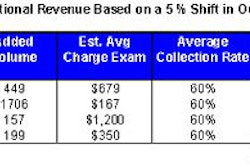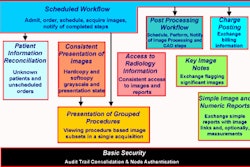Many of the benefits ascribed to PACS involve better service to referring physicians. But are clinicians truly ready for filmless radiology? If the experience of the Cottage Health System is any indication, the answer is a definite yes.
"Physicians really use the system, and they really like the system," said Dr. Michael Trambert of Cottage Hospital in Santa Barbara, CA. He made his comments during a scientific session at the 2002 Symposium for Computer Applications in Radiology in Cleveland.
Cottage Health System, which includes three hospitals, has had its CT, ultrasound, and MRI units hooked up to an enterprise PACS network (DR Systems, San Diego) in April 1998, with special procedures added in February 1999. Conventional radiography was incorporated in May 2001 following implementation of computed radiography. All three Cottage imaging departments are filmless except for mammography.
Universal accessibility is a key benefit of the Cottage PACS installation, with approximately 900 PCs having access to the PACS network, Trambert said. Local-area network access to PACS was provided to the radiology department, as well as the OR, ICU, CCU, and ER units, he said.
Nursing stations and physician offices have Web-based access to the PACS. The outpatient clinic is connected to the PACS over a LAN, while referring physicians at the outpatient clinic have Web-based access.
While interpreting the image, the radiologist selects a montage of images and can annotate the images with text and arrows. The radiologist also prepares a voice clip up to a minute long that describes the findings. The montage and voice clips are permanently bound to the exam on the online server, image archive, and on the Web server, he said.
Both LAN and Web-based access is provided using the same application and user interface, which means that referring physicians only have to learn the process once, Trambert said. Access is provided in compliance with the Health Insurance Portability and Accountability Act (HIPAA), with user names and passwords, secure socket layer (SSL) encryption, and audit trails.
To access images and reports, referring physicians type in a patient's last name, and the results are immediately available. If desired, the physicians can also view the entire study, as well as comparison exams for side-by-side review, Trambert said.
About 95% of the Cottage referring physicians have medium-to-high bandwidth access (such as cable, DSL, wireless, or Ethernet fiber connections) to the network, with low-bandwidth access (56K modems) used by only 5% of physicians.
To test referring-physician satisfaction with PACS, Cottage conducted a survey of 139 physicians in the spring of 2001. Thirty-seven responded, including 31 specialists and six primary care physicians.
Only one physician was not comfortable using the Web-based access, and all physicians felt that it saved time, Trambert said. Nearly unanimously, the physicians said that it expedited and improved patient care. Of the respondents, 90% said that they don't want to receive routine calls from the radiology department for routine results, owing to availability of "virtual" access to results.
The Cottage researchers believe that PACS enhances the role of the radiologists, who remain the center of interpretation, he said. The montage images selected by the radiologist were rated "not valuable" by 2 respondents, "neutral" by 7, "valuable" by 18, and "very useful" by 8. Voice clips were depicted as "neutral" by two, "valuable" by 20, and "very useful" by 13.
"(The PACS has provided) a virtual extension of the radiologist's presence directly into the referring physician's office," he said.
The researchers also discovered a significantly decreased level of consultations. For example, conversion to CR led to a sevenfold decline in consultations, Trambert said. As a result, referring physicians and radiologists are more efficient, as are the front offices of the radiology department and referring physicians.
The study team also performed a WebLog file analysis, calculating Web access to the PACS network over a 10-day period in late 2001. During that time frame, 1,896 cases were viewed and 568 voice clips played.
"Universal accessibility to images and results (over the LAN and the Web) have been extremely successful at our institution," Trambert said. "We've found the perception that this expedites and improves patient care; it helps referring physicians because the information is available when and where they want it."
By Erik L. RidleyAuntMinnie.com staff writer
June 11, 2002
Related Reading
SCAR R&D Committee releases RT productivity study, May 5, 2002
Digital departments need rigorous QA program, May 5, 2002
Monitor choice impacts diagnostic accuracy and throughput, May 4, 2002
Web-based image distribution to OR fits the bill, May 4, 2002
Imaging advances continue to drive, challenge PACS, May 4, 2002
Copyright © 2002 AuntMinnie.com



















